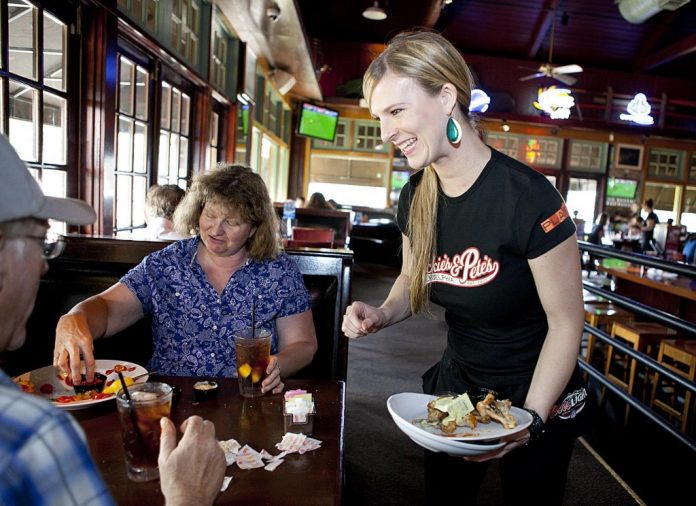Melissa Galm chats with diners at Chickie’s & Pete’s on Roosevelt Boulevard. Galm, a recent Holy Family grad, did an academic study for a finance class with nine of her co-workers. They found that, on average, the women made more money in tips as blon
Melissa Galm and Holy Family professor Dr. Cao Jiang reached a colorful conclusion from their research study that asks, “Do blonde waitresses get better tips than brunettes?”
Melissa Galm graduated from Holy Family University in December with a bachelor’s degree in finance and the wisdom gleaned from thousands of hours in the classroom.
Yet perhaps the most practical lesson she learned was actually one of the simplest.
Some might even think of it as simple-minded.
Galm discovered that blondes do, in fact, have more fun — that is, if you consider it fun to make more money in your job by changing something as simple as your hair color.
In their recently completed research study, Galm and her finance professor, Dr. Cao Jiang, found that the waitresses at Northeast Philadelphia’s popular sports bar and restaurant, Chickie’s & Pete’s, make more money in tips when they forgo their natural, darker hair color in favor of blonde.
Galm proposed the study late last year for her portfolio analysis and investment management class with Jiang.
Because Galm was being evaluated on her concept, and not necessarily her execution of it, the study — under normal circumstances — would never actually have seen the light of day.
But in January, the National Conference on Undergraduate Research — to whom Jiang had submitted Galm’s idea — accepted it as a valid area of research and encouraged her to pursue it.
So with the conference’s advocacy and the support of Holy Family’s administration, Galm spent the next two months surveying about a dozen servers at Chickie’s & Pete’s Roosevelt Boulevard location, where Galm works part time.
For 30 days, the women wore their natural hair colors (or the colors they were wearing immediately before the study began). Then they changed colors for the next 30 days. The dark-haired waitresses, including Galm, went blonde, and a couple of blondes went brunette.
“Basically, there was an increase in the percentage of earnings (for those who changed to blonde hair),” Galm said. “It was 1.37 percentage points, which doesn’t seem like that much. But if someone was a server full time for a year, it could mean two to three thousand dollars a year.”
According to Jiang, a Ph.D. who is chairman of the finance department at Holy Family, he and Galm analyzed tip amounts as a percentage of the corresponding customer bills. That is, the darker-haired Chickie’s & Pete’s servers collected tips at a 17.26-percent rate before going blonde, then at an 18.63-percent rate after lightening up.
There were only two waitresses who started blonde and went dark, not enough of a sample to draw conclusions for that group.
“From the data, it does seem to support that maybe people subconsciously do tend to tip (waitresses) who are fair-haired better,” Galm said.
The real beauty of Galm’s concept, according to Jiang, is that it took into account countless variables that otherwise might have skewed the data. For example, tips might also be influenced by the body type and physical attractiveness of individual servers, by their personalities, by the specific shifts worked and by the demographics of the customers.
Yet by using the same women for both study groups — the dark-haired and the blonde — the authors were able to control most of the variable factors, leaving hair color as the lone glaring variable.
“The idea, in that aspect, is pretty mature,” Jiang said. “(Undergraduates) don’t know how to do all of the academic work — the hypothesis and statistical analysis — but the concept is (Galm’s) and that’s the important part.”
Beyond that, Galm also was able to tap into a facet of research that even seasoned academics often struggle to grasp. She managed to attract widespread interest for her work. Local print, television and radio journalists have interviewed Galm on the subject. A radio station in Cincinnati also heard about the study and contacted her via Facebook.
“We never expected this mass media,” Jiang said. “Ultimately, the goal of this particular study was to get published (in a professional journal).”
Call it a lesson in the practical application of classroom theory. People, by and large, seem to be very curious about blondes and their tip money.
“As a business researcher, your study would have no value if it didn’t have a practical sense,” Jiang said. “For practical research, it has to resonate. It has to be interesting to other people.”
A bit of controversy usually helps, too. “With the stereotypes of blondes being dumber or more beautiful, it’s a constant battle,” Galm said. “People seem to be very opinionated about it.” ••
Reporter William Kenny can be reached at 215–354–3031 or [email protected]





